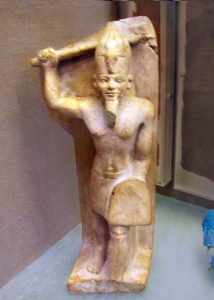There is a member of the infernal council allied against God you’ve probably never heard of—except that you have but you don’t know it.
Chapter 3 of the Book of Habakkuk, a prayer that summarizes God’s battles on behalf of Israel, refers to several of the rebellious “sons of God.”
God came from Teman,
Habakkuk 3:3–5 (ESV)
and the Holy One from Mount Paran. Selah
His splendor covered the heavens,
and the earth was full of his praise.
His brightness was like the light;
rays flashed from his hand;
and there he veiled his power.
Before him went pestilence,
and plague followed at his heels.

“Pestilence” (Deber) and “plague” (Resheph) were known as demons or deities by the pagan nations around the Hebrews in the days of the prophets. We should assume that the prophets knew about them, too. Here, Habakkuk described Deber and Resheph as subservient to Yahweh. They may even have been prisoners of war from an earlier conflict, as God marched off from Mount Sinai (Paran is an alternate name for Sinai) to do battle against the gods of Canaan.
While Deber was a minor character among the gods of the ancient Near East, he is mentioned about fifty times in the Bible. Since his name is usually translated “pestilence” or “plague,” however, only scholars who spend their lives studying this kind of thing have noticed. The most obvious reference to Deber as an entity, rather than a natural disaster, is the scripture above, which is Habakkuk’s prelude to his account of Joshua’s Long Day.
But back in the third millennium BC, Deber was a bigger deal. The texts at Ebla, the ancient city near Aleppo mentioned earlier in this book, Deber was called dingir–eb-laki, the “god of Ebla.”[1] In other words, the demonic creature called “pestilence” in the Bible was the patron god of the earliest known political power in northern Syria.
At this point you may be asking why this is relevant. Here’s why: Because Habakkuk named the pestilence-god Deber as a colleague of Resheph, the plague-god, when he told the story of the Exodus and the attack on Canaan, and he described them as servants or prisoners of Yahweh.
How did God convince Pharaoh to let His people go?
Right. Plagues and pestilence.
Before the showdown at the Red Sea, which was directed at the king of the Canaanite pantheon, Baal, God subdued two other West Semitic deities, Deber and Resheph. He either overpowered them and compelled them to do His bidding, or He simply demonstrated that they were powerless to protect the people holding Israel captive.
What do we know about Resheph? Even you though may not have heard his name, Resheph was one of the most popular gods in the ancient Near East for nearly three thousand years.
He was a warrior god, described as a divine archer who spread plague with his arrows. At Ugarit, Resheph served the Canaanite sun-goddess Shapash as the gatekeeper of the underworld. This identifies Resheph as the Babylonian god Nergal, who was likewise an archer, a plague-god, and gatekeeper of the netherworld.
As Nergal, the god was considered a fierce and terrible warrior. He was sometimes called Erra, who, in this guise, was an agent of chaos and destruction, responsible for periods of political and social instability. He was a “warrior,” the “lord of plague and carnage,” or “lord of affray and slaughter.”[2] Based on the number of copies found by archaeologists, a poem called the Epic of Erra must have been one of the most popular pieces of literature in the ancient world, even though it’s not nearly as well known as the Gilgamesh epic.[3] It describes how Erra/Nergal ravaged the land with plague after gaining temporary control of the world, nearly destroying mankind in the process.
The root word behind Resheph’s name appears to mean “flaming,” or “burning,” or even “lighting,” possibly a metaphorical reference to the fever that accompanies the plague.
One intriguing biblical reference to Resheph comes from the Psalms, where God’s punishment of the Egyptians for their treatment of Israel is described.
He gave over their cattle to the hail
Psalm 78:48–50 (ESV)
and their flocks to thunderbolts.
He let loose on them his burning anger,
wrath, indignation, and distress,
a company of destroying angels.
He made a path for his anger;
he did not spare them from death,
but gave their lives over to the plague.
“Plague” in verse 50 is the pestilence-god Deber, not Resheph. But here’s the interesting part: The thunderbolts in verse 48 are connected to Resheph and not the storm-god, Baal. Even more interesting, the verse literally reads, “He gave over their cattle to the hail and their flocks to the rǝšāpîm”—the “reshephs.”[4]
Consider this: Since the root word behind the type of angelic beings called seraphim, saraph, also means “burning,” thus making the seraphim “burning ones,” is it possible that the reshephim are also a class of angel? It’s speculation, but possible. An inscription from the Phoenician city of Sidon in the fifth century BC names one of the city’s quarters “Land of the Reshephs.”[5]
Possibly identifying a previously unknown type of angel is intriguing stuff, but we’ll set that aside for another book. The takeaway from Psalm 78 is that the judgments against Egypt were carried out by “a company of destroying angels,” which included Deber, Barad (“hail”), and Resheph (or the “reshephs”).
The worship of Resheph goes way back, at least to 2500 BC. One of the four city gates of the ancient city of Ebla was named for Resheph. The other three were named for “the” god, Dagan, the storm-god Baal, and Sipish, which was the Eblaite spelling of Shamash, the sun-god.
So, the Big Four among the gods of ancient Ebla were Dagan (AKA El/Molech), Baal, Shamash, and Resheph. The patron god of the city, oddly enough, was the pestilence-god Deber. God dealt with all five of those Eblaite gods in the Old Testament.
If you’re having a bad day, just imagine how depressing would it have been to live in a town where the main deities included the god of plague, the god of pestilence, and Dagan, who was called “lord of the corpse.”
The cult of Resheph extended south into Egypt, probably carried by the Amorites who took over Lower (northern) Egypt as the Hyksos kings in the seventeenth century BC, just about the time Joseph was brought there as a slave. Egyptians continued to worship Resheph for centuries, past the time of Ramesses the Great, who ruled Egypt about two hundred years after the Exodus. Resheph was often depicted in Egyptian art alongside Min, a fertility god, and Qetesh, a goddess of “sacred ecstasy” who was probably the Egyptian form of Astarte/Ishtar/Inanna.
Now, get this: A native Egyptian king in the fifteenth century BC adopted Resheph as one of his personal gods and his special protector in battle.[6] This was probably because of the deity’s warrior aspect as a god of horses and chariots. That king was Amenophis II, also known as Amenhotep II.[7] Scholar Douglas Petrovich has made an excellent case that Amenhotep II, devotee of Resheph, was the pharaoh of the Exodus.[8]
Think about that for a minute. The pharaoh whose special supernatural protector was the plague-god, a divine warrior who was also a god of horses and chariots, was convinced to release the Israelites because his personal god couldn’t stop the devastating plagues sent by Yahweh—including the final plague that claimed the life of the pharaoh’s first-born son.
Then Pharaoh’s elite chariot corps was destroyed, drowned beneath the waves of the Red Sea.
But wait—there’s more! And we’ll get to that next week.
[1] Giovanni Pettinato, The Archives of Ebla: An Empire Inscribed in Clay. (Garden City, NY: Doubleday & Company, Inc., 1981), 247.
[2] “Erra (god).” Ancient Mesopotamia Gods and Goddesses,http://oracc.museum.upenn.edu/amgg/listofdeities/erra/, retrieved 12/14/18.
[3] Peter Machinist, “Rest and Violence in the Epic of Erra.” Journal of the American Oriental Society 103.1 (1983), 221.
[4] “Hail” is the Hebrew Barad, another entity who was apparently part of God’s “company of destroying angels.”
[5] Paolo Xella, “Resheph.” In K. van der Toorn, B. Becking, & P. W. van der Horst (Eds.), Dictionary of Deities and Demons in the Bible (2nd extensively rev. ed.). (Leiden; Boston; Köln; Grand Rapids, MI; Cambridge: Brill; Eerdmans, 1999), 702.
[6] Ibid., 701.
[7] Maciej M. Münnich, The God Resheph in the Ancient Near East. (Tübingen: Mohr Siebeck, 2013), 102.
[8] Douglas N. Petrovich, “Amenhotep II and the Historicity of the Exodus-Pharaoh.” https://www.academia.edu/1049040/_2006_Amenhotep_II_and_the_Historicity_of_the_Exodus-Pharaoh, retrieved 12/12/18. Also published online at https://biblearchaeology.org/research/chronological-categories/exodus-era/3147-amenhotep-ii-and-the-historicity-of-the-exodus-pharaoh.


If you’re having a bad day, just imagine how depressing would it have been to live in a town where the main deities included the god of plague, the god of pestilence, and Dagan, who was called “lord of the corpse.”
that made my day!
Also I just love learning more about the God I love and the country I love – Israel-
Who is like my God
Whom shall I compare him to?
He is fairer than 10,000
He is the lily of the valley
He is the bright and morning star
He is the son of man
He is the final son of Adam
He conquered death, the grave and he intercedes before the throne room of grace
Beloved Apostle Paul formerly known as Rabbi Shaul of Tarsus was on his way to Damascus
He met him
Adonai
the Messiah
the Prince among all princes
Yahweh
Micah means Who is like Yahweh!
Love that book!
God’s greatest work was through the frailty of his son.
Of whom shall I be afraid for who is like my God?
No one!
Therefore I shall not fear even though the mountains will fall into the sea
The righteous run into the name of the LORD and they are saved!
I enjoy these emails
Add to my worship of the only one and true living God.
The God of Abraham, Isaac and Jacob
3 in one
One God but 3
Love Daniel chapter 7 Vision of the Ancient of Days
9“I watched till thrones were put in place,
And the Ancient of Days was seated;
His garment was white as snow,
And the hair of His head was like pure wool.
His throne was a fiery flame,
Its wheels a burning fire;
10A fiery stream issued
And came forth from before Him.
A thousand thousands ministered to Him;
Ten thousand times ten thousand stood before Him.
The court was seated,
And the books were opened.
11“I watched then because of the sound of the pompous words which the horn was speaking; I watched till the beast was slain, and its body destroyed and given to the burning flame. 12As for the rest of the beasts, they had their dominion taken away, yet their lives were prolonged for a season and a time.
13“I was watching in the night visions,
And behold, One like the Son of Man,
Coming with the clouds of heaven!
He came to the Ancient of Days,
And they brought Him near before Him.
14Then to Him was given dominion and glory and a kingdom,
That all peoples, nations, and languages should serve Him.
His dominion is an everlasting dominion,
Which shall not pass away,
And His kingdom the one
Which shall not be destroyed.
Many trust in horses and chariots
but the righteous run into the name of the LORD and they are safe/saved!
Maranatha
In Christ
Mel
Thank you for all that you do for us for teaching us a deeper more personal reading of the Bible thank you so much we love you God is using you keep it up so you can wake us up
Wow, such a good article this week. All are good, but this one is particularly fascinating. Had me hooked all the way to the end! Love this deep dive research on Deber and Resheph. Really looking forward to next week’s edition. 👍
Thanks Derek